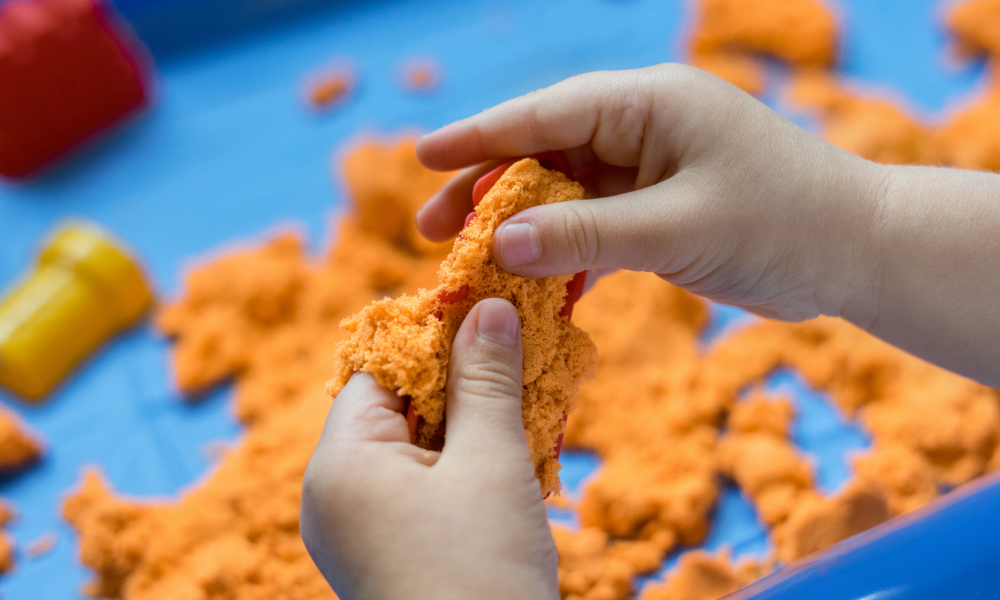As the weather gets chilly, caregivers often find themselves looking for engaging activities to keep their children active and stimulated indoors.
One valuable approach that stands out during this season is sensory play. Sensory play not only keeps kids entertained but also offers a host of developmental benefits, making it an ideal choice for children, especially those with sensory sensitivities or fine motor delays. In this blog, we’ll explore the importance of sensory play during the colder months and share some creative ideas for sensory activities!
Why Sensory Play Matters
Sensory play is a vital component of a child’s early development, as it engages their senses in a variety of ways. Here’s why it’s particularly important during the winter season!
Stimulates the Senses
Cold weather often limits outdoor sensory experiences. However, sensory play compensates by providing tactile, visual, and auditory stimulation indoors.
Cognitive Development
Engaging with different textures, temperatures, and materials during sensory play enhances cognitive development. Children learn to explore, observe, and draw connections.
Fine Motor Skills
Many sensory activities involve manipulating small objects, pouring, and scooping. This helps in developing fine motor skills, which are crucial for tasks like writing and dressing.
Emotional Regulation
Sensory play can be calming for children with sensory sensitivities. It helps them manage their sensory experiences and emotions.
Cold Weather Sensory Play Ideas
Sensory Bins
Sensory bins provides an opportunity for children to explore multiple senses in a safe and contained way.
You will need a large plastic container, materials like rice, dried beans, small toys or objects.
Instructions:
Fill the container with the chosen sensory material. Add small toys or objects for children to discover. Encourage them to explore and describe what they feel.
Cold Weather Themed Sensory Bins:
Here are some cold weather themed sensory bins to help you get started!
Arctic Animal Sensory Bin
– Fill a bin with white cotton balls or shredded coconut to mimic snow
– Add arctic animal figurines, such as polar bears, penguins, seals, and whales
– Include ice cubes, reusable ice cubes or small ice packs, or clear plastic gems to represent icebergs
– Encourage children to explore the sensory bin and create arctic scenes, fostering imaginative play and sensory exploration
Hot Cocoa Sensory Bin
– Use brown kinetic sand or cocoa powder as the base to resemble hot cocoa
– Add miniature marshmallows (real or faux), spoons, and cups
– Children can scoop, pour, and serve “hot cocoa” to practice fine motor skills and enjoy a cozy sensory experience!
Winter Nature Sensory Bin
– Collect winter-themed natural objects like pinecones, acorns, or evergreen branches
– Add a base of sand or rice
– Children can explore the different textures of these nature items and use them for imaginative play
Sensory Bottles
Craft sensory bottles filled with water, glitter, and small items. Seal the bottles securely. These mesmerizing bottles offer visual and auditory stimulation as children shake, twist, and observe the objects floating within the bottle!
Icy Ocean Sensory Bottle
– Fill a clear bottle with water
– Add blue food coloring for a cold water effect
– Include small plastic fish or sea creature figurines
– Seal the bottle tightly, and children can gently rock it to observe the underwater scene
Cold Weather Discovery Bottle
– Fill a bottle with water and add baby oil to create separation
– Include various objects like small pinecones, evergreen branches, and fake snow
– The baby oil and water layers give the impression of different textures in the bottle, promoting visual and tactile exploration
Hot Cocoa Taste Test
Create a sensory-rich hot cocoa taste test for your child by offering different variations of hot cocoa. Use various ingredients like different types of cocoa powder, sweeteners (such as sugar and honey), milk or milk alternatives, and toppings like whipped cream, marshmallows, or cinnamon.
Encourage your child to engage in a sensory experience by:
– Describing the different aromas from each cup
– Observing the colors and textures of the hot cocoa
– Tasting each variation and discussing the flavors and sweetness levels
This activity not only stimulates the sense of taste but also promotes vocabulary development as your child describes their preferences and sensory experiences with each cup. It’s a delicious way to explore seasonal flavors and engage in meaningful sensory exploration!
Frozen Pom-Poms
Creating a Frozen Pompom sensory activity can be an engaging way to stimulate a child’s sensory exploration, especially during the cold months.
Frozen Pompom Sensory Play
Materials you’ll need:
- Pompoms (various sizes and colors)
- Ice cube trays or silicone molds
- Water
- Freezer
Instructions:
- Prepare the Pompoms: Gather an assortment of pompoms in various sizes and colors. You can find these at craft stores or online
- Ice Cube Tray or Silicone Molds: Take an ice cube tray or silicone molds. You can use various shapes, such as hearts or stars, to add an extra layer of excitement to the sensory play
- Freeze the Pompoms: Place individual pompoms or small groups of them in each compartment of the ice cube tray or silicone mold. Distribute the pompoms evenly, mixing different colors and sizes
- Add Water: Fill each compartment with water, covering the pompoms. You can use clear water or tint it with a bit of food coloring for added fun!
- Place the ice cube tray or silicone mold in the freezer and allow the pompoms to freeze completely. This usually takes a few hours or overnight
- Sensory Playtime: Once the frozen pompoms are ready, remove them from the tray or mold. Provide a large bin or container for your child to explore the frozen pompoms
Here’s what your child can do with the frozen pompoms:
– Sensory Exploration
The cold, textured surface of the frozen pompoms offers tactile sensory input. Children can touch and hold them, experiencing the contrast of different temperatures.
– Color Sorting
If you’ve used pompoms of different colors, your child can sort and categorize them based on color.
– Size Sorting
Pompoms come in various sizes. Encourage your child to sort them by size, developing their fine motor skills and cognitive abilities.
– Language Development
Engage in conversations about the sensory experience. Ask questions about how the frozen pompoms feel, their colors, and whether they are cold or warm to touch.
– Thawing Fun
As the frozen pompoms start to melt, children can observe the transition from solid to liquid, which can be a captivating science lesson!
Be sure to supervise the play, especially for younger children who might be tempted to put the pompoms in their mouths.
This activity is not only sensory-rich but also an excellent way to have fun and learn about temperature changes in a safe and engaging manner.
Add droppers, warm water, containers & scoops. This is great for fine motor skills and provides opportunities exploring freezing and melting!
Engage in Indoor Sensory Play This Season!
Sensory play should be all year for children, but it can be especially valuable during the colder months when outdoor play may be limited. By encouraging sensory exploration, you’re fostering cognitive development, fine motor skills, and emotional regulation, all in a fun and engaging manner.
These activities are not only beneficial but also an enjoyable way for children to pass the time and create lasting memories. So, embrace the joy of winter sensory play and watch your child thrive, even on the coldest of days!



